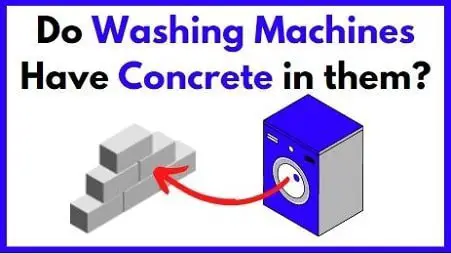Washing machines are heavy no matter what brand you choose.
But do you know why your washer is so heavy?
Well, that’s because your washer has concrete blocks installed in it.
Washing Machines do have one or more concrete blocks installed in them depending on their size and type. These concrete blocks are actually made up of cement and their main purpose is to balance the electric motor and gearbox that are attached to the inner tub.
In short, a concrete block stabilizes the washing machine while running through the wash cycles.
The quantity and the volume of these concrete blocks depend on the washer’s capacity.
Typically, concrete blocks inside the washer can weigh up to 25 kg or even more and the actual weight of the washer without the concrete block may weigh less than half of what the block weighs.
Why is there a concrete block in the washing machine?
The concrete blocks are placed inside the washer in order to prevent them from shuffling or moving especially during the spin cycle.
During the spin cycle, the heavy motor drives the gearbox attached to the inner washtub at a very high spin speed.
Without the heavy concrete block, the washer may move and become unstable.
Stabilization Mechanism
Concrete blocks are strategically placed within washing machines to counteract the vibrations and forces generated during various cycles, especially high-speed spin cycles.
These vibrations can lead to the washer moving or shaking, potentially causing damage or decreasing performance.
Balancing the Motor and Gearbox
Washing machines contain an electric motor and gearbox that operate to agitate and spin the drum.
These components generate considerable rotational forces.
Concrete blocks, due to their weight and rigid structure, help distribute and offset these forces, reducing excessive movement and maintaining stability.
Inertia and Damping
Concrete blocks possess high inertia, meaning they resist changes in motion. When the washer’s motor generates movement, the concrete blocks counteract by resisting changes in their own motion.
This dampening effect minimizes the transmission of vibrations to the rest of the machine, preventing unnecessary movement.
Reducing Vibrations
During spin cycles, the drum and components can experience imbalances, leading to vibrations.
Concrete blocks act as counterweights, helping to balance the load and reduce vibrations caused by uneven distribution of clothing.
This results in a smoother and quieter operation.
Improving Energy Efficiency
Stabilizing the washing machine through concrete blocks also contributes to energy efficiency.
A stable machine experiences less energy loss due to unnecessary movement, leading to optimized performance and reduced power consumption.
Where is concrete in the washing machine? Types and Placement
Concrete blocks can vary in size and weight depending on the washing machine’s capacity and design.
They are often positioned at the base of the machine, providing a low center of gravity and enhancing stability.
The weight of these blocks holds the surface and maintains the balance while the washer functions.
Depending on the washer type, front loaders may have 2 blocks installed, one above the washtub and another at the base.
In some cases, front-loading washers may have additional blocks above the drum to balance loads more effectively.
Can you remove the concrete block from a washing machine?
Yes, these concrete counterweights can be removed and may require some physical effort, as you may have to uncover most of the parts installed above and around these blocks.
These concrete blocks can be removed or replaced in the event of any damage or wear-outs and in order to remove or replace these counterweights, you will need expert assistance.
What happens if you remove the concrete from the washing machine?
Your washing machine will become lighter if you remove the concrete weight.
This means during the high RPM wash cycle, the washer will vibrate and leave its position.
Removing concrete blocks destabilizes the washer.
Replacing concrete blocks in washing machine
If you need to replace a damaged or worn-out concrete block in your washing machine, it’s important to follow proper procedures to ensure safety and effectiveness:
Safety First
Before attempting any repairs, disconnect the washing machine from the power source and water supply to prevent accidents.
Expert Assistance
Replacing concrete blocks can be complex, as it often involves disassembling parts around the blocks.
Seeking expert help is advisable, particularly if you lack familiarity with appliance repairs.
Gaining Access to the Blocks
Depending on your washing machine’s configuration, accessing the concrete blocks might necessitate removing the top, back, or front panel.
Consult the manufacturer’s manual or consult a professional for accurate guidance.
Removing Adjacent Components
Be prepared to take off any parts that impede your reach to the concrete blocks.
Disconnecting wires, hoses, or other parts may be necessary to accomplish this.
Gently Removing Blocks
Once you’ve gained access, carefully detach the damaged concrete block. Since they can be heavy, use proper lifting techniques to avoid injury.
Replacing and Securing
Position the new concrete block in the same location as the old one. Ensure it’s properly aligned and secured in place.
For appropriate installation, follow any instructions or guidelines provided by the manufacturer.
Reassembly
Put back any parts you removed to access the blocks. Double-check that all components are securely in place before reassembling the machine.
Final Thoughts
The concrete blocks are meant to balance the washer during the high-speed spin and it’s not recommended to remove them as it will not only void the warranty but also destabilize the washer.
We don’t see any reason why you may want to remove the concrete block unless it has broken into pieces and makes an intolerable sound during wash cycles.
It’s best not to touch the concrete blocks inside the washer.
Lastly, we think instead of placing a concrete block, the machines could have been designed with a heavy or thick body.
Manufacturing washers with heavy or thick bodies will not only help to stabilize the washer but also provide that extra space occupied by the concrete block, but again it’s just a thought 🙂
You May Also Like

